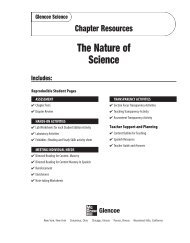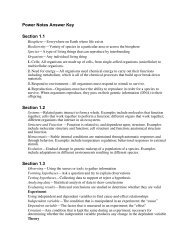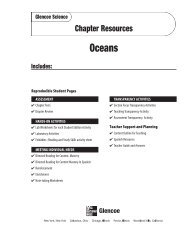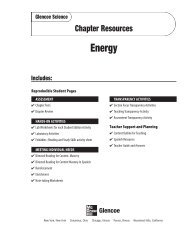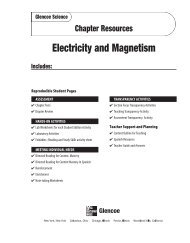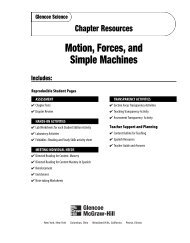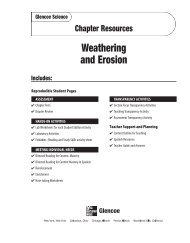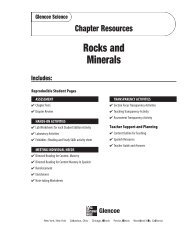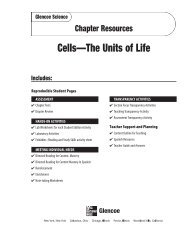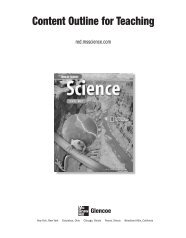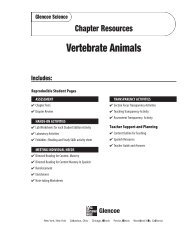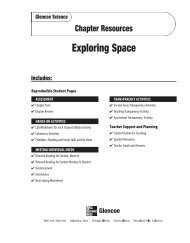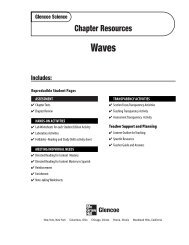Chapter 21 Resource: Ecology
Chapter 21 Resource: Ecology
Chapter 21 Resource: Ecology
- No tags were found...
Create successful ePaper yourself
Turn your PDF publications into a flip-book with our unique Google optimized e-Paper software.
Copyright © Glencoe/McGraw-Hill, a division of the McGraw-Hill Companies, Inc.Teacher Guide & Answers (continued)2. Without natural predators, the falcon populationsare more likely to grow. This can causeproblems, as a larger population can outgrow itsfood sources.3. Answers will vary, but may include Canadageese, common crows, squirrels, and rats thatare successful because of plentiful food and lackof predation.Section 2 (page 27)1. Lab experiments make it possible to controlother things in the frogs’ natural habitat thatmight be affecting them, such as radiation orpredators, and to compare the pond water withother water in the same conditions. Answersshould include the idea that if something in thewater is harming frogs, it might also harm otherliving things, including humans. It is importantto find out what that something is to understandhow it is harming frogs and possibly otherliving organisms.2. Deformed frogs make easier prey and may haveproblems reproducing themselves, which willlead to smaller frog populations.3. Students can learn about the problems andhelp educate others. They can also not dumpmaterials in storm drains and use moreenvironmentally-friendly productsSection 3 (page 28)1. The cheetah can only run at top speed for shortdistances.2. Because lions can steal the prey while thecheetah rests after its chase. The cheetah’s lackof sharp claws, along with its smaller size andstrength, make it unable to fight off lions.3. The spots provide camouflage in the grasses, sothe prey will not see the cheetah stalking it.4. A town would have no open spaces for thecheetah to stalk and chase prey.Note-taking Worksheet (page 29)Refer to Teacher Outline; student answers areunderlined.Assessment<strong>Chapter</strong> Review (page 33)Part A. Vocabulary Review1. population (1/1)2. biosphere (1/1)3. producers (1/1)4. abiotic factors (1/1)5. biotic factors (1/1)6. limiting factor (2/1)7. ecosystem (2/1)8. ecology (2/1)9. decomposers (2/1)10. consumers (4/1)11. habitat (3/2)12. niche (3/2)13. community (3/2)Part B. Concept and Skill ReviewExamples will vary. Possible responses are given.1. rocks, water, sun (1/1)2. birds, plants, decomposers, animals (1/1)3. all the squirrels in an area; all the oak trees in anarea (2/1)4. all the populations in a forest (2/1)5. Bacteria decompose dead organisms. Agrasshopper is food for a bird. (2/1)6. any place an organism lives (2/1)7. any organism that feeds on another (2/1)8. bacteria, mushrooms (2/1)9. light, water, temperature (2/1)10. green plants (2/1)11. grass ➝ insect ➝ bird ➝ cat (2/1)12. competition (4/2)13. predation (4/2)14. predation (4/2)<strong>Ecology</strong> <strong>Chapter</strong> Test (page 35)I. Testing Concepts1. e (1/1)2. b (2/1)3. a (4/2)4. d (1/1)5. c (2/1)6. b (1/1)7. c (2/2)8. c (1/1)9. c (3/2)10. d (5/3)11. b (3/2)12. e (3/2)13. d (5/3)14. c (1/1)15. a (4/2)16. a (3/2)17. d (5/3)18. a (6/3)19. d (3/2)20. c (1/1)II. Applying Concepts1. Answers will vary, but should properly definebiosphere as the part of Earth where organismscan live, refer to it as a single ecosystem, andexplain how all smaller ecosystems can existonly in the biosphere. (1/2)2. Examples include the following: an aquarium, arotting log, a stream, a forest (1/2)3. Examples include: water temperature, soil orsand in stream bed (2/1)4. Answers should indicate that an organism needsits habitat to survive in order to fill its niche andthat the niche is found within the habitat. (4/2)Teacher Support & Planning<strong>Ecology</strong>T11




